C-2.1 Types of Plumbing Appliances
Plumbing appliances differ from plumbing fixtures in that they are not operated by water only. Their operation may depend on the setting of controls or on the characteristics of items, such as heating elements, motors, pumps or sensors. Plumbing appliances can be made from various materials to suit the intended application.
Garbage Disposal Units
Garbage disposals (Figure 1) (also known as garbage grinders or garburators) are devices that are installed under a kitchen sink and attached to the sink outlet fitting. A small but powerful 120 V electric motor is turned on manually after the vegetable cuttings or food debris is placed into the disposal unit. A constant flow of water from the faucet is needed to facilitate the process. Spinning blades (“hammers”) chop the large pieces until a thin slurry is formed that can be washed down the fixture drain.
Some jurisdictions do not allow the installation of garbage grinders because they contribute a significant amount of food solids to the public sewer system that must then be removed and treated. For the same reason, they should not be installed in systems that drain to a private sewage disposal system. With the trend toward composting organic materials and other food waste, fewer people use disposal units nowadays.

Dishwashers
A dishwasher (Figure 2) is an electrical/mechanical device for cleaning dishes and utensils. Dishwashers can be found in restaurants and private homes. Unlike manual dishwashing, which relies mainly on physical scrubbing to remove soiling, a mechanical dishwasher cleans by spraying the dishes with hot water, typically up to 60°C (140°F). These high temperatures are required for sanitization.
A mix of water and detergent is circulated by a pump to one or more rotating spray arms, which blast the dishes with the cleaning mixture. Once the wash is finished, the wash water is drained, and more hot water is admitted as the rinse cycle begins. After the rinse cycle finishes and the sump is drained again, the dishes are dried by one of several different drying methods (usually heating elements, although some may also use a fan to speed the process).
Mechanical dishwashing devices were developed in the mid to late 1800s. The domestic dishwasher was invented in the 1920s, but it did not see widespread use until the 1950s. By the 1970s, dishwashers had become a common item. Present-day machines feature a drop-down front panel door, allowing access to the interior. The inside of a dishwasher is typically constructed of either stainless steel or plastic.
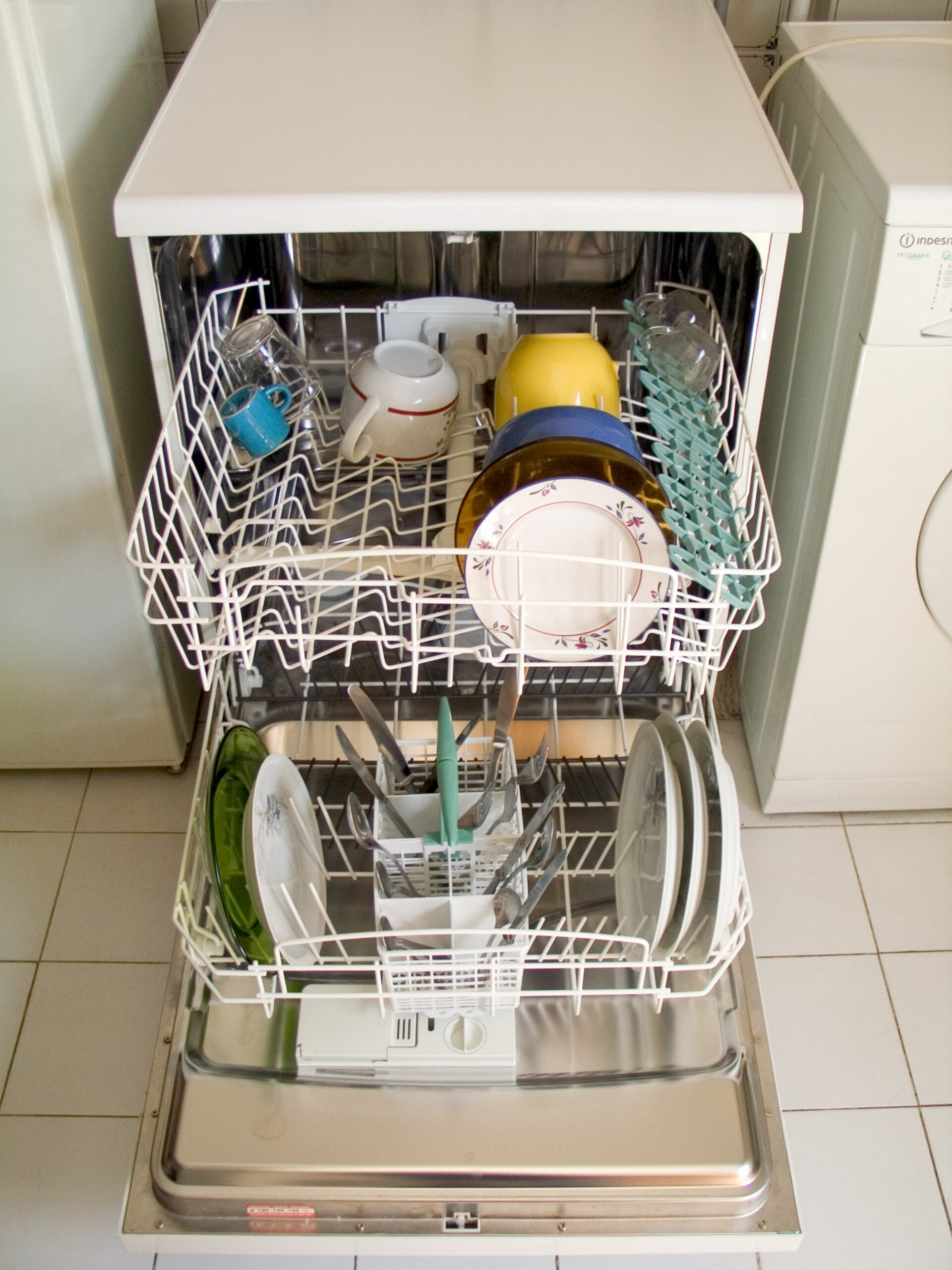
High-temperature commercial dishwashers use water heated to an extremely high temperature to clean and sanitize dishes and glassware. Because of this, there is no need for chemicals or dish detergent to be added during the dishwashing process.High-temperature dishwashers must meet National Sanitation Foundation (NSF) standards and heat water to an approved temperature of 82°C (180°F). In some cases, high-temperature dishwashers require the addition of a booster heater (Figure 3) to aid in this process. While some high-temperature dishwashers include a booster heater with the dishwasher, others do not; the booster heaters must be installed separately in the latter case. The booster heater elevates water temperature in the final rinse state to properly sanitize dishware and glassware.
Clothes Washers
A clothes washer (Figure 3) (also known as a laundry machine or washing machine) is an appliance used to wash laundry, such as clothing and linen. The term mostly applies to machines that use water and detergents as opposed to ultrasonic cleaners or dry cleaning (which uses alternative cleaning fluids and is performed by specialized commercial businesses).

Automatic clothes washers use motors and gears to rotate agitator blades inside a steel or plastic cylindrical tub. They rely on electromechanical timers to sequence the washing and water extraction process. Solenoid valves and pumps control the flow of water in and out of these appliances. Hoses attached to a set of dedicated laundry hose bibbs or to a laundry box connect to hot and cold supplies.
The first domestic automatic washing machine was introduced in 1937. In appearance and mechanical detail, this first machine was not unlike the front-loading automatic washers produced currently. Although it included many of today’s basic features, the machine lacked any drum suspension and, therefore, had to be anchored to the floor to prevent “walking.” Because of the components required, the machine was also very expensive.
The modern process of water removal by spinning did not come into use until electric motors were developed. Spinning requires a constant high-speed power source and was originally done in a separate device known as an extractor. A load of washed laundry would be transferred from the wash tub to the extractor basket, and the water spun out in a separate operation.
What is now referred to as an automatic clothes washer was at one time referred to as a washer/extractor. These combine the features of the two devices into a single machine that also has the ability to fill and drain water by itself. Also available are compact appliances that merge the automatic washing machine and clothes dryer into a single device, called a combo washer dryer (not to be confused with stackable washers and dryers). While combo washer dryers are not as effective and efficient as some full-sized, fully functional, separate washer and dryer machines, the combos provide a viable option for those who can benefit from having a compact machine that is able to both wash and dry clothes (like smaller urban residences). Some top-loading clothes washers also come with a built-in sink.
Water Heaters
Water heaters heat potable water for cleaning and bathing purposes. They are also called domestic water heaters, or simply hot water tanks. There are two basic types of water heaters: tankless and storage tank.
Tankless water heaters (Figure 4) (also called on-demand water heaters) heat water as it flows through the device and do not retain any water internally except for what is in the heat exchanger coil (although some units do maintain a very small storage vessel to avoid initial delivery of cold water to the user). These appliances typically use electricity, natural gas, or propane. Copper heat exchangers are often preferred in gas-fired units because of their high thermal conductivity and ease of fabrication; however, stainless steel heat exchangers offer superior resistance to corrosion and leakage.
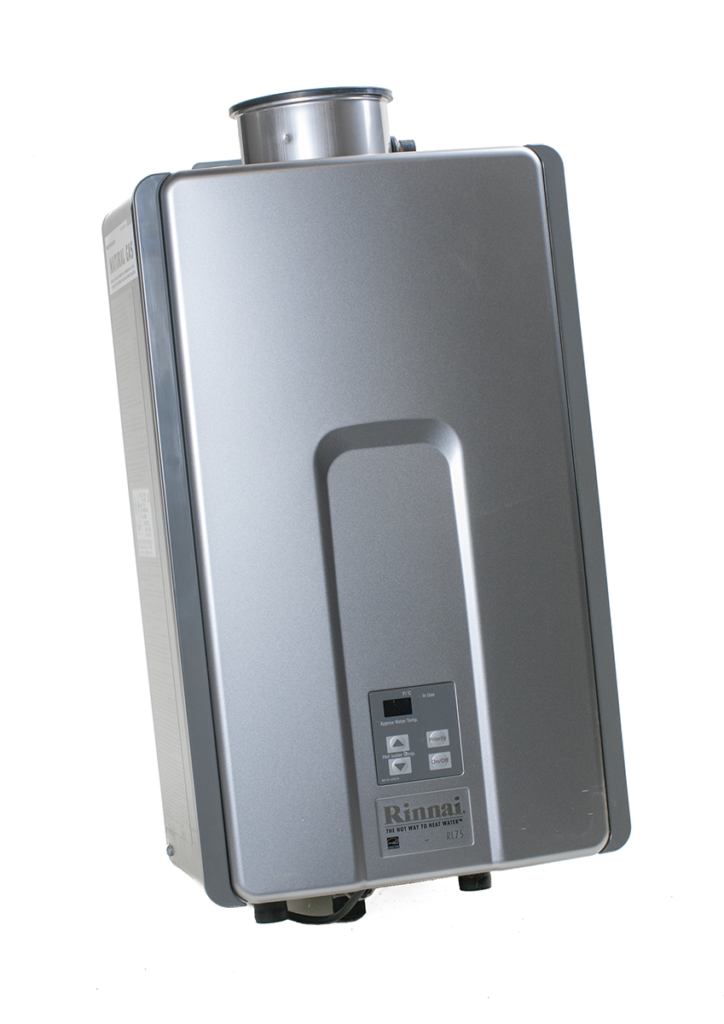
The greatest advantages of these appliances are their small footprint (most units are wall-mounted and can be placed near the point of use) and the energy savings afforded by very low standby heat losses. Disadvantages include the high rate of energy consumption when in operation and the somewhat limited flow rates based on the temperature rise of incoming cold water and the setpoint required.
Storage tank water heaters have traditionally been the most common water heaters in household and commercial applications in North America. Also called storage water heaters or hot water tanks, these consist of a cylindrical vessel that keeps water continuously hot and ready to use. Typical sizes for household use range from 75–400 L (20–100 US gal.). These appliances use electricity, natural gas, propane, heat pumps, solar, or other energy sources.
The energy source may heat the potable water directly (like an immersed electric element or a gas-fired burner) or indirectly (with an internal or external heat exchanger). Indirect storage tanks with heat exchangers are heated by energy that is transferred from other appliances, such as space heating boilers or solar thermal collectors.
Compared to tankless heaters, storage water heaters have the advantage of using energy at a relatively slow rate, storing the heat for later use. The disadvantage is that over time, the water inside the tank will cool down, causing the heating system to activate to heat the water back up. Additionally, once the tank’s supply of hot water has been exhausted, there is a significant delay before hot water is available again. Larger storage tanks tend to provide hot water with less temperature fluctuation at moderate flow rates.
Whirlpool Tubs
Whirlpool tubs (Figure 5) use air and water jet combinations from an integral or remote pump. Whirlpool tubs first became popular in North America during the 1960s. A spa or whirlpool tub is sometimes referred to as a Jacuzzi, since the word became generic after plumbing component and pump manufacturer Jacuzzi introduced the Spa Whirlpool in 1968. Air bubbles are commonly introduced into the whirlpool tub nozzles as a 50/50 mixture of air and water through a venturi-style pump. Most piping is factory installed.
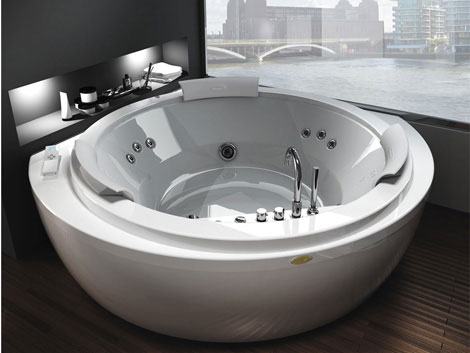
Steam Showers
Self-contained steam showers often come complete with seating for one or more people. The cabin provides adequate floor space for everyday showering while offering the option to unwind with a steam session. Additional available features include overhead showers, hydro massage body jets, and Wi-Fi music capabilities. Special attention to design is required for multi-head showers, including adequate water pipe sizing. A steam shower may have a separate steam generator or a built-in unit. There may be special plumbing requirements for the steam generator such as a pressure reducing valve, backflow preventer, or relief valve drain.
Ice Makers
Residential ice makers are typically an integral component of the refrigerator, whereas commercial ones are stand-alone units.
Residential Ice Makers
Most residential ice makers (Figure 6) are installed in a refrigerator and use an electric motor, an electrically operated water valve, and an electric heating unit to produce ice cubes.

At the beginning of the cycle, a timed switch energizes a solenoid valve that allows in just enough water to fill the ice mould. Once the mould is filled, the machine waits for the water in the mould to freeze. The cooling unit in the refrigerator does the actual work of freezing the water not the ice maker itself. When the temperature drops to a specific level, an internal thermostat closes a switch in the electrical circuit, which energizes a heating coil underneath the ice maker. As the coil heats up, it warms the bottom of the ice mould, loosening the cubes from the mould. The electrical circuit then activates the ice maker’s motor, which rotates a set of ejector blades that remove the cubes from the mould. The cubes are pushed out to a collection bin underneath the ice maker.This system is effective for making ice at home, but it does not produce enough ice for commercial purposes, such as restaurants and hotels.
Commercial Ice Makers
Commercial ice makers (Figure 7) have dedicated refrigeration systems. Most types make their ice in a large metal ice-cube tray positioned vertically inside the unit. The ice maker has a water pump that draws water from a collection sump and pours it over the chilled ice tray. As the water flows over the tray, it gradually freezes, building up ice cubes in the well of the tray. After a set amount of time, the ice maker triggers a solenoid valve connected to the heat-exchanging coils. Switching this valve momentarily changes the path of the refrigerant gas within the cycle. As the hot gas is forced through the evaporator pipes, the pipes and the ice tray heat up rapidly, loosening the ice cubes so that they slide out into a collection bin below.
This sort of system is popular in restaurants and hotels because it makes clear ice cubes of a standard shape and size.
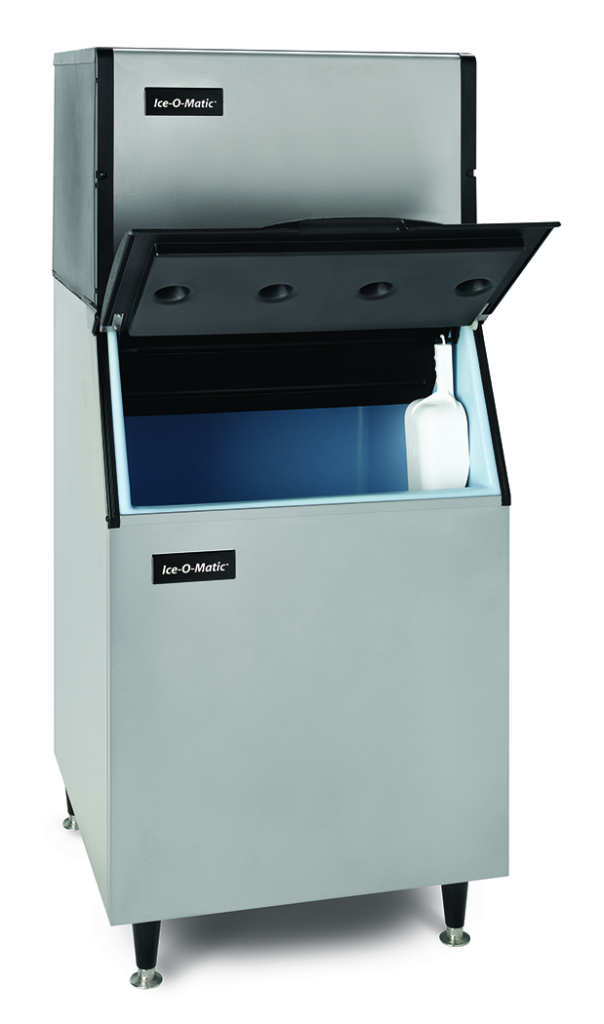
Water Purifiers
Water purifiers are appliances that use physical and/or chemical methods to treat water to a required condition. The most common types of physical purification systems use activated carbon to remove latent chemicals and trapped gases, providing water with a superior taste.
To remove minerals and fluorides from water sources, ion exchange–type water softeners are often used that operate between regeneration, service, and backwash modes using a sodium brine solution and a synthetic resin bed. Electronic timers operate the mechanical valves required to bypass equipment while in regenerating mode.
Reverse osmosis water treatment equipment is also effective at removing salts and minerals from raw water sources. These units use pre-filters, a thin film composite membrane, and post-filters to effectively remove pollutants and microorganisms.
Ultraviolet sterilizers (Figure 8) are used to kill viruses and bacteria in water supplies. They require an electrical connection to operate the UV bulb in the reactor vessel.
Most purification equipment operates without the use of additional pumps, relying on the pressure drop of the water system to provide the required flow. Some exceptions include the addition of chemical dosing equipment that uses electric pumps to administer the correct amount of solution required or in cases where supply pressure of the source water is inadequate, and a booster pump is required. A backflow preventer may be required on water purification installations. Check with the local jurisdiction for more information.
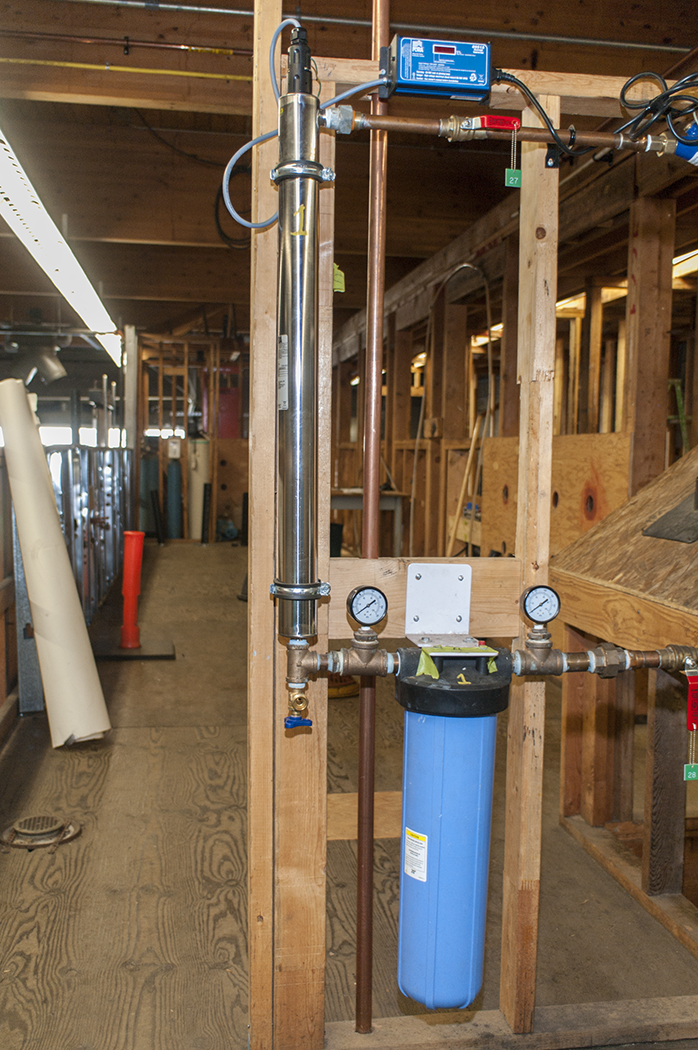
Beer Cabinets
Beer cabinets are often refrigeration-equipped appliances that cool bottles or kegs of beer (Figure 9). Some require a water supply and possibly an indirect connection to a floor drain. Some beer cabinets have an integrated glass rinser that can be used to condition the glass with cold water before pouring.
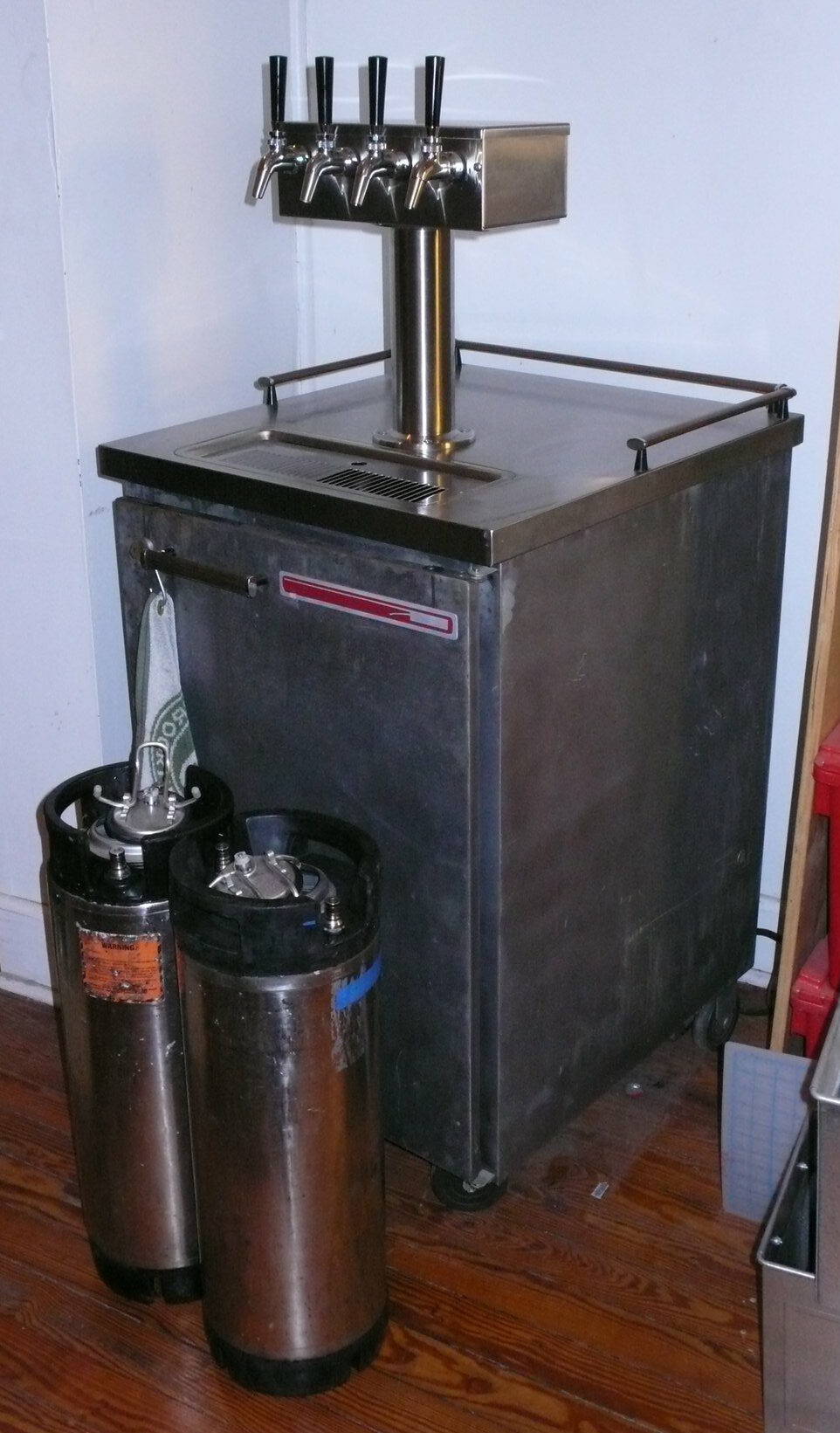
 Self-Test C-2.1: Types of Plumbing Appliances
Self-Test C-2.1: Types of Plumbing Appliances
Complete Self-Test C-2.1 and check your answers.
If you are using a printed copy, please find Self-Test C-2.1 and Answer Key at the end of this section. If you prefer, you can scan the QR code with your digital device to go directly to the interactive Self-Test.

References
Skilled Trades BC. (2021). Book 2: Install fixtures and appliances, install sanitary and storm drainage systems. Plumber apprenticeship program level 2 book 2 (Harmonized). Crown Publications: King’s Printer for British Columbia.
Trades Training BC. (2021). C-2: Install appliances. In: Plumber Apprenticeship Program: Level 2. Industry Training Authority, BC.
Media Attributions
All figures are used with permission from Skilled Trades BC (2021) unless otherwise noted.
- Figure 2 Residential dishwasher is by wax115 on FreeImages® and is used under the Freeimages.com Content License.
- Figure 5 Whirlpool tub by jingdianjiaju2 on Flickr is used under a CC BY-SA 2.0 license.
- Figure 9 Homebrew Kegerator [Beer cabinet] is by Kyle Van Horn on Flickr and is used under a CC BY 2.0 license.
(Garburator); A device installed under a kitchen sink that uses a motorized grinder to break down food waste into a slurry that can be washed down the drain. (Section C-2.1)
An electrical and mechanical appliance that cleans dishes by spraying them with hot water and detergent, followed by rinsing and drying cycles. (Section C-2.1)
A device that raises water temperature, often used in high-temperature dishwashers to ensure proper sanitization. (Section C-2.1)
(Washing Machine); A household appliance that washes laundry using water, detergent, and an internal agitation mechanism. (Section C-2.1)
An electrically controlled valve that regulates the flow of liquids or gases in appliances such as washing machines and dishwashers. (Section C-2.1)
(Also called on-demand water heaters); A water heating system that heats water on demand without storing it in a tank. (Section C-2.1)
A water heater that continuously stores and heats a supply of water in a cylindrical tank. (Section C-2.1)
A bathtub equipped with jets that mix air and water to create a massaging effect. (Section C-2.1)
A self-contained shower unit with an integrated steam generator for steam bathing. (Section C-2.1)
A device that automatically produces ice cubes, commonly found in refrigerators or as standalone units. (Section C-2.1)
A water purification process that removes contaminants by forcing water through a semipermeable membrane. (Section C-2.1)
A water purification device that uses UV light to kill bacteria and viruses. (Section C-2.1)
A plumbing device designed to prevent contaminated water from flowing back into the clean water supply. (Section C-2.1)
A refrigeration unit used to store and cool beer, sometimes equipped with a glass rinser for preparing glasses before pouring. (Section C-2.1)

